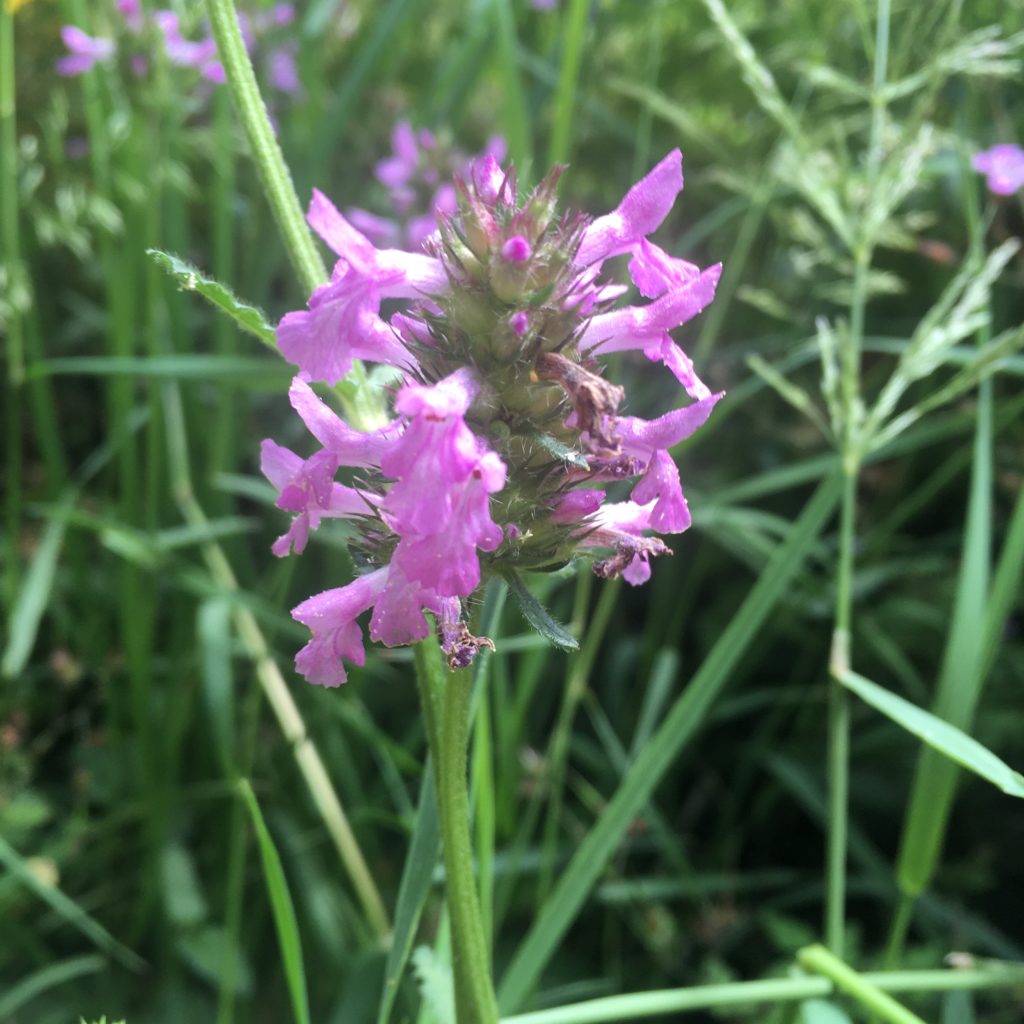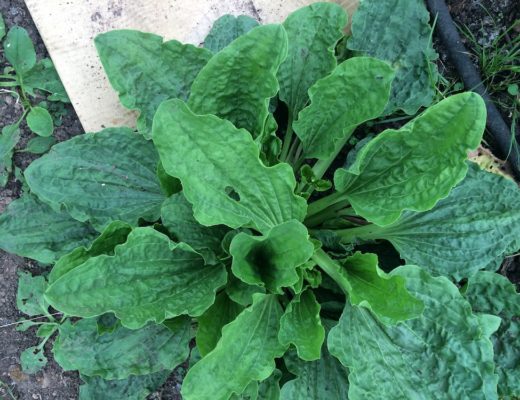Please note these plant profiles are a work in progress. I will always be adding to them as I keep learning about the amazing world of plant medicine.
Botanical Overview
Latin name: Betonica officinalis syn. Stachys officinalis
Plant family: Lamiaceae (mint family)
Identification: Herbalist Zoe Hawes writes that Betony is a perennial plant that grows every spring from a fibrous root system, to 30cm (1ft) high. It has many short-stalked, round, toothed leaves at its base and a square stem with occasional unstalked leaves. The flowers grow directly from the stem, mainly at the top of the dense flowerhead. They are pinkish-purple and trumpet-shaped, with a flat upper lip and three-lobed lower lip, arising from a green, spiked calyx (1).
Other species: Can be mistaken for Marsh woundwort (Stachys palustris)
Folk names in English: Betony, Wood Betony, purple betony, bishopwort, bishop’s wort
Chemical constituents: Volatile oils, bitter principles (betolide, iridoids), tannins (rosmarinic acid, caffeic acid derivatives), alkaloids (betonicine, stachydrine), flavonoids, choline, coumarins (2).
Food and nutrition
The leaves and flowering tops can be drunk as a tea.

Ecological role
Wood betony mainly grows in meadows and partially shaded ground on the edge of woodland or in hedgebanks. It may also be found in open grassland (1).
Cultivation: Plants can be started from seed in autumn or spring. They can also be propagated from cuttings or the clumps can be divided.
Energetics
- Temperature: Cooling (bitter), warming (aromatics)
- Moisture: Drying
- Tissue State: Dry/Atrophy, Wind/Tension
- Taste: Mild bitter
Health challenges supported by Betony
Herbal actions: Vulnerary, astringent, nervine relaxant, nervine trophorestorative, bitter tonic, carminative, antispasmodic, expectorant, sedative, emmenagogue
Writing in 1653, Culpepper quotes the physician of Emperor Augustus from the first century AD (almost 2,000 years ago). He recommended betony for headaches, colds, coughs, epilepsy, fevers, indigestion, labour pains and wounds and wrote: “It is a very precious herb, that is certain” (4). Throughout the medieval period, Betony was considered one of the most superior protection medicines(2).
Wound healing: Betony’s gentle astringent and vulnerary action make it useful in first aid for cuts, scrapes and wounds. Fresh leaves can be crushed into a paste or made into a spit poultice to apply to bites. It has a gentle drawing action making it useful for stings and splinters.
Supporting the nervous system: Betony can help ease tension and anxiety through its relaxant action while building up nervous system strength through its trophorestorative effect. Betony has a particular affinity with people experiencing nervous exhaustion, pain and physical tension, especially when combined with other nervine herbs. Anne McIntyre writes that betony relieves nerve pain and is helpful in trigeminal neuralgia and sciatica (3). Wood betony has also been used traditionally for convulsions and nervous palpitations. It has also be used in hypertension formulas.
Supporting the digestive system: Betony has several herbal actions that can support the digestive system. It is mildly bitter making it useful for stimulating secretions of the liver, gallbladder, pancreas, stomach, small and large intestines to aid digestion. Betony can also help calm wind, cramps and tension in the digestive tract through its carminative and nervine actions. This mild relaxant effect also makes it useful for cramping, bloating and colic. It has an affinity for gut issues relating to stress, trauma or general nervous-system deficiency through overstimulation of the autonomic nervous system.
Leaky gut: Betony’s vulnerary action is also useful internally. It can be combined with other herbs as part of a protocol for intestinal permeability, otherwise known as a leaky gut syndrome.
Neck, shoulder and muscle pain: While not often the first choice, it is worth noting that betony’s relaxant and antispasmodic action on smooth and skeletal tissue, can make it useful for people with neck and shoulder pain. Especially as this pain is so commonly from tension due to stress. Betony’s cleansing action through the liver and kidneys can make it helpful in arthritis and gout (3).
Reproductive system support: Betony’s affinity for the nervous system makes it useful for people struggling with premenstrual tension. Anne McIntyre writes that it stimulates uterine muscles and can bring on delayed periods, while its astringent tannins are useful in heavy bleeding (3). Its cooling qualities can also make it useful for menopausal flushes. It is also used to help treat benign enlargement of the prostate (3).
Respiratory infections: Betony has a gentle expectorant action. It is also antiseptic. Traditionally, it’s been used in treating coughs brought on by the environment, weather or turning of the seasons (2). As a hot tea, it can help treat catarrh and sinusitis.
Headaches: Betony is commonly used in the treatment of headaches and migraines, particularly for tension-based headaches. Sajah Popham says that betony can also be remedial for deficiency type headaches due to reduced blood flow to the brain via its promotion of cerebral circulation and opening up of the arterial blood supply to the head (2). He also shares information on Betony’s traditional uses for minor traumatic brain injuries and associated symptoms such as difficulty concentrating, dizziness, vertigo, ringing in the ears, foggy thinking, headaches or feelings of disassociation. Betony can also be useful for enhancing cognitive function, short term memory and to generally sharpen cognitive faculties.
Herbalist Sajah Popham paints a constitutional picture of when Betony may be suitable: “We have general digestive symptoms present, with an overall thin, weak and deficient constitution, coldness in the periphery, brain fog and/or headaches from lack of cerebral circulation, musculoskeletal tension, ungroundedness, lack of confidence/willpower, potential liver stagnation/tension, and nervous debility- or what the old docs called “neurasthenia.” This overall pattern covers issues associated with the stomach, small intestine, liver and gallbladder. All of these things ultimately boil down to weakness in the solar plexus, which Wood Betony corrects in a gentle yet profound way. The best way to think of this remedy is that it brings the vital force from the top of the head and down into the solar plexus.” (2).
Cautions
Betony has a slight stimulant effect on the uterus and is, therefore, contraindicated for pregnant people.
Betony and the Solidarity Apothecary
Betony has not been as abundantly available on the land where I live, so I have not used it widely in supporting people with the Solidarity Apothecary. However, it is an incredibly useful plant in our nervine materia medica, especially for people who experience debilitating headaches due to chronic stress. Chronic stress from state repression affects people’s bodies in such different ways, many people experience headaches as one of their main symptoms.
Sources
- Wild Drugs, Zoë Hawes
- Betony monograph, Materia Medica Monthly produced by the Sajah Popham at the School of Evolutionary Herbalism
- The Complete Herbal Tutor, Anne McIntyre
- Hatfield’s Herbal, Gabrielle Hatfield





No Comments